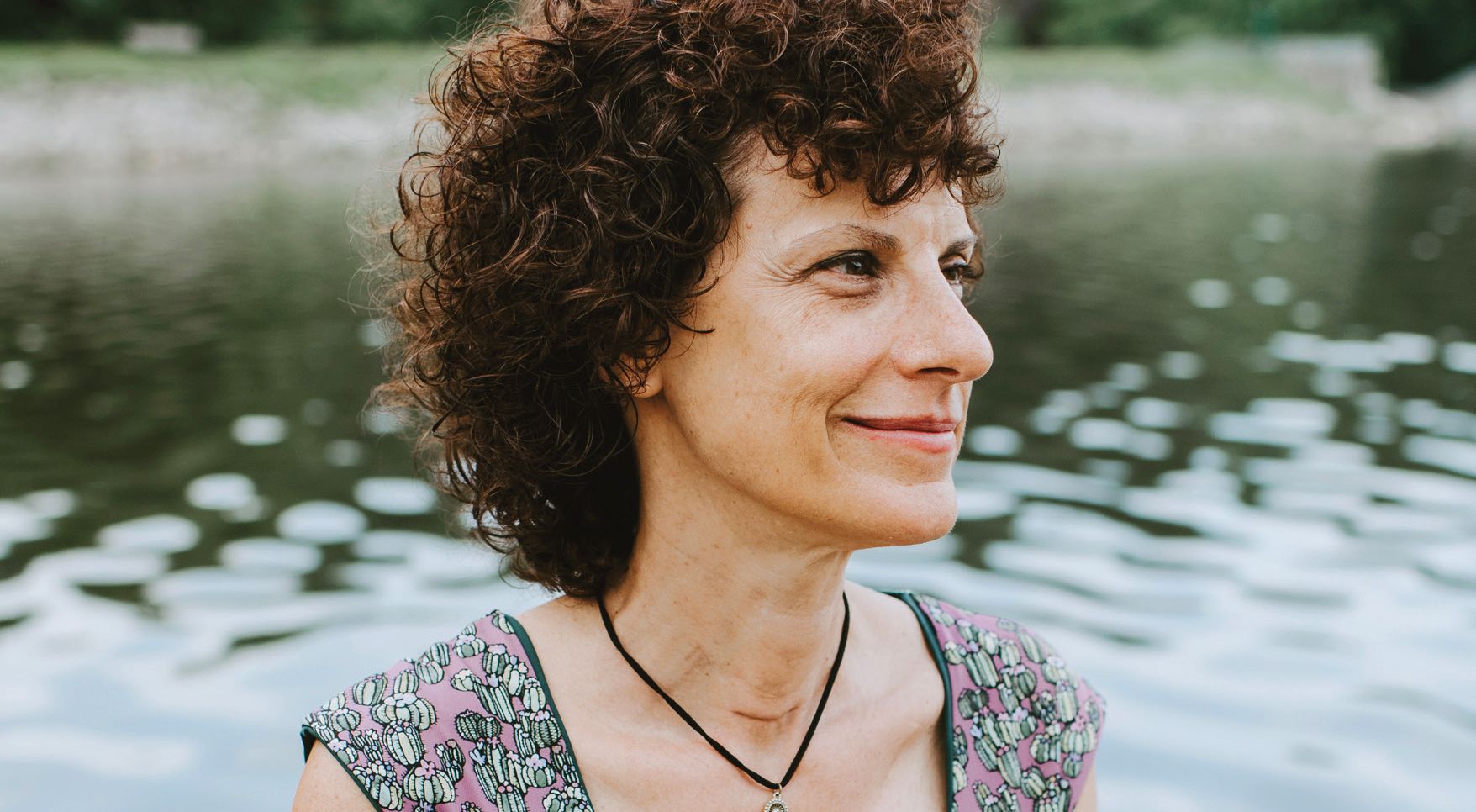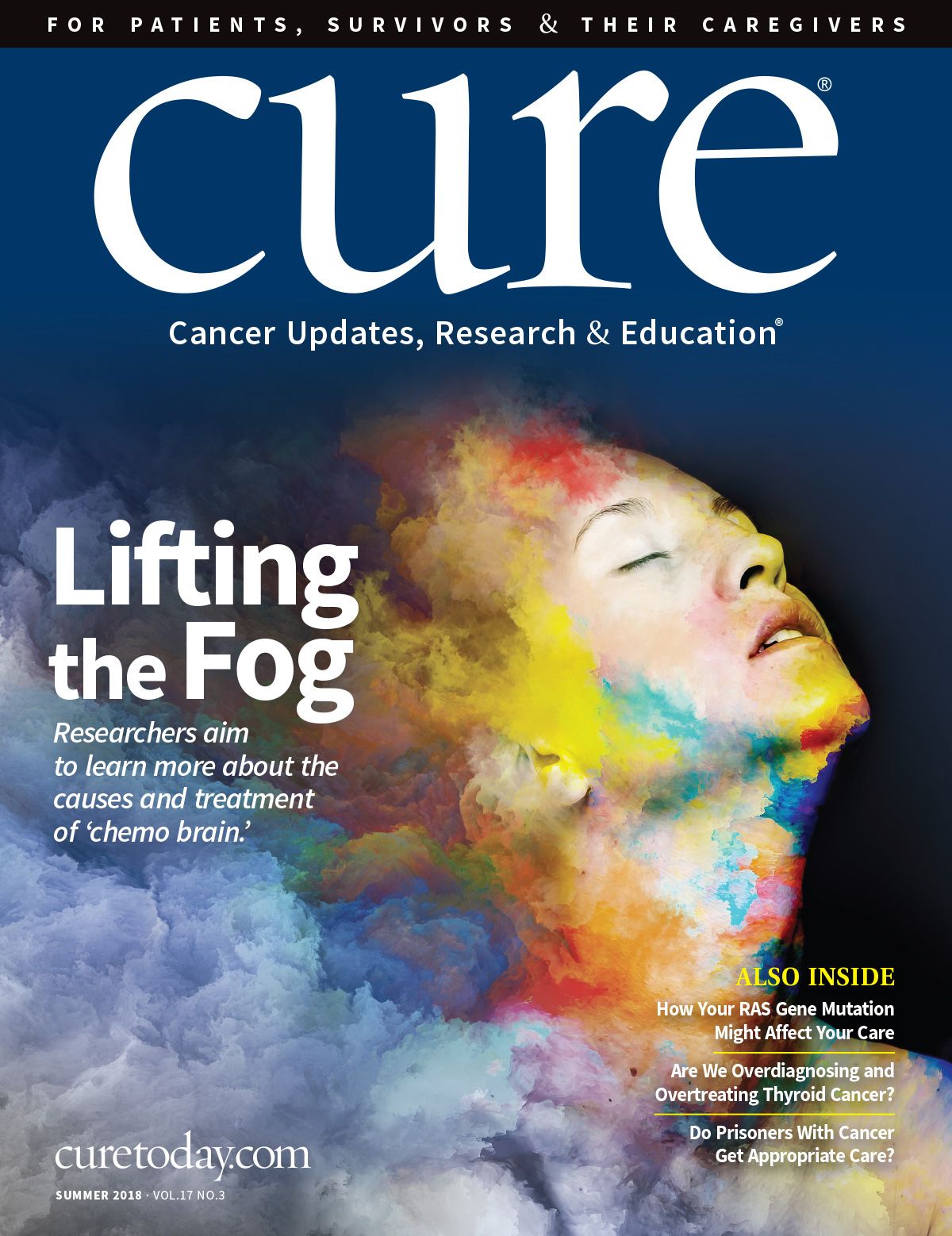Publication
Article
CURE
Stop, Look and Listen: Surveillance Is an Option for Thyroid Nodules
Author(s):
Instead of undergoing surgery for potential cancer, many people with thyroid nodules can safely opt for surveillance.
ROBERTA KASMAN, M.D., was found to have a thyroid mass during a checkup for an unrelated condition. - PHOTO BY EUNICE KIM

ROBERTA KASMAN, M.D., was found to have a thyroid mass during a checkup for an unrelated condition. - PHOTO BY EUNICE KIM
It was practically by accident that Roberta Kasman, M.D., learned she had a lump on her thyroid.
Kasman, now 61, had gone to her endocrinologist to request a different osteoporosis medication. During the visit, her doctor felt a mass in her neck and ordered a needle biopsy.
It came back benign, so Kasman was given the option of monitoring the lump with ultrasounds every six months. The first ultrasound showed no growth. But by the second one, a year after the lump was found, the mass had grown substantially, so Kasman chose to have it taken out through a thyroid lobectomy — removal of the half of the thyroid gland that contained the nodule.
“After the lobectomy in February, the pathology reports came back positive for cancer, so I had the whole thyroid removed in March (2018),” says Kasman, a retired orthopedic surgeon in Fairfax, Virginia.
Kasman’s disease is part of a recent surge in cases of thyroid cancer in the U.S. Experts are divided as to whether the uptick reflects an actual increase in cases or whether doctors are simply finding more cases incidentally due to increased use of CT scans, ultrasounds and other technology that can pick up previously undetectable nodules. Some say it’s a combination of these.
WHAT IS THYROID CANCER?
As researchers try to tease out a more precise explanation, many patients living with suspicious thyroid masses face the often difficult and sometimes misunderstood choice between monitoring and surgery.
The thyroid, a butterfly-shaped gland at the front of the neck under the Adam’s apple, produces a hormone that regulates heart rate, blood pressure, body temperature and weight. Commonly, overgrowths of tissue, called nodules, grow on the thyroid. In rare cases, these are cancerous. Papillary thyroid cancer, which accounts for 89 percent of cases of the disease, typically grows slowly. It can spread to the lymph nodes in the area, but even then, the prognosis is excellent. Follicular thyroid cancer accounts for about 5 percent of cases. This riskier form of the disease is more likely to spread to distant organs, including the lungs and bones.
Medullary thyroid cancer, which can be slow growing or aggressive, accounts for about 2 percent of cases and tends to run in families. Anaplastic thyroid cancer, occurring in less than 1 percent of cases, is aggressive and less likely to respond to treatment.
Most thyroid cancer is curable with surgery, although targeted drugs are available for the rare cases that continue to progress. The five-year survival rate over the past five years was greater than 98 percent. When papillary thyroid cancer, in particular, stays within the thyroid gland, the 10-year survival rate is 100 percent. The smaller the tumor and the younger the patient, the better the prognosis.
Thyroid cancer is most common in people who were exposed to high doses of radiation as children or adolescents, have a low-iodine diet or a family history of thyroid cancer and are over 40. It also seems to affect women at higher rates than men. In most cases, however, doctors don’t know its exact cause.
Compared with other oncologic diseases, thyroid cancer is relatively rare. The National Cancer Institute estimates that 53,990 cases will be diagnosed in 2018 — compare that with 266,120, the number of new cases of female breast cancer expected in 2018. Still, rates have nearly tripled since 1975, when researchers began keeping track of thyroid cancer cases.
MORE CANCER OR JUST MORE CASES?
“That kind of increase, from 4.9 per 100,000 to about 14.3 per 100,000, is really unusual,” says Louise Davies, M.D., an associate professor at The Dartmouth Institute and chief of head and neck surgery at the Veterans Affairs Medical Center in White River Junction, Vermont.
Experts offer a few explanations for the swell in cases over the past four decades. Each explanation may account for some portion of the increase. “There clearly is some overdiagnosis,” says Michael Tuttle, M.D., an endocrinologist who treats thyroid cancer at Memorial Sloan Kettering Cancer Center in New York City. That means that screening finds harmless cancers that would have been best ignored but instead lead to testing, patient anxiety, treatment and, with it, attendant side effects.
“Every time you go to the emergency room, somebody gets a neck CT or a carotid ultrasound,” Tuttle says. Doctors now find nodules smaller than a centimeter that never would have been detected or biopsied before, he explains. Because thyroid cancer mortality has largely stayed the same despite the rise in incidence, researchers believe that many of the cases contributing to the increased prevalence would never become symptomatic or life-threatening.
In fact, up to half of the adult population has thyroid nodules by 60 years of age, and around 10 percent of adults have thyroid cancer that they don’t know about. These asymptomatic cancers are too small to cause lumps that can be felt by patients or their doctors and are found just in autopsy studies following death by another cause.
“We are probably just diagnosing things that, in many cases, we could at least wait (to address) until they demonstrate growth,” says Jochen Lorch, M.D., a medical oncologist and director of the Thyroid Cancer Center at Dana-Farber Cancer Institute in Boston.
Although all diagnoses are to some degree a judgment call, a change in how pathologists label thyroid lesions may offer another explanation. “Pathologists may be labeling lesions as sclerosing or tall-cell variant (indicating a more aggressive cancer) more often than they used to because of slightly shifting criteria or judgment patterns over time,” Davies says.
NOW OR LATER?
Still, data show true growth, albeit slow, in the rate of aggressive papillary thyroid cancers, such as the diffuse sclerosing and tall-cell subtypes, that must be treated no matter what their size. Researchers are unsure why this smaller increase in aggressive cancers has occurred. “Does it have something to do with hormones, plastics, solvents, cell phones, electromagnetic waves? We don’t know what’s actually causing this, but it seems to be real,” Lorch says.
Nevertheless, the vast majority of new thyroid cancers are nonaggressive and low risk. So, how can doctors tell which can be watched instead of treated?
When doctors see a suspicious thyroid nodule, they typically order a needle biopsy, also called fine needle aspiration, to collect cells from the mass that are examined under a microscope. Biopsies can come back positive for cancer, negative (benign) or — about 30 percent of the time — uncertain.
Until recently, people with indeterminate results would have some or all of their thyroid removed to get a diagnosis, which for many led to going on hormone replacement medication for the rest of their lives. Only about one in five of those cases turned out to be cancer, meaning that most of the surgeries had been unnecessary. Meanwhile, those found to have cancer who had undergone just partial thyroidectomy may have needed a second surgery.
No blood test can determine which small tumors will stay small and which will progress, but two commercially available tests, ThyroSeq and Afirma, can help determine which nodules are cancerous — without surgery. Using gene-sequencing technology, these tests detect mutations associated with benign or cancerous nodules.
They also test for an array of genes with the goal of helping determine how urgently a thyroid cancer should be treated.
Scientists believe that these genetic indicators characterize the threat posed by specific thyroid cancers; for example, BRAF and TERT gene mutations are associated with more aggressive cancers.
But even with the help of such tests, it’s difficult to definitively identify aggressive cell types, Tuttle says. So, when the biopsy or, ultimately, the gene test is positive but the nodule is small, it can be hard to tell whether the lesion will one day grow and require removal. “It is just additional pieces of information to help the patient and the clinician further estimate the risk that an individual nodule is cancer or not,” he says, “not necessarily whether surgery or observation is needed.”
In rare cases, even small nodules already show signs that they should be removed, such as nearby lymph node involvement or growth outside the thyroid. “These never come into the discussion for observation,” Tuttle says.
“The only cancers that come into the discussion,” he adds, “are those that are by definition low risk. You’re trying to find the most aggressive goldfish in the bowl. But it’s still a goldfish. It’s not going to misbehave terribly.”
Only small papillary cancers can be considered low risk, and how to define “small” is still up for debate. “We have data to support monitoring cancers that are less than a centimeter, but data for cancers in the 1-2-centimeter range is still evolving,” Davies says. Just under 40 percent of papillary thyroid tumors are diagnosed at 1 centimeter or less.
Another consideration: Nodules that are candidates for active surveillance can’t be too close to the recurrent laryngeal nerve, which makes the vocal cords work. “(The nodule) needs to be well encapsulated with some healthy thyroid tissue around it, sort of in the middle of the gland,” Davies says.
Someone whose thyroid cancer meets these criteria can opt to either have it removed, usually through a partial thyroidectomy, or follow it with ultrasounds every six months. “If we’re wrong and it’s a little bigger in six months or a little bigger in a year, it’s still very treatable, and we haven’t lost anything,” Tuttle says.
If the cancer doesn’t grow after a couple of ultrasounds, the care team might reduce the frequency of follow-up.
Whether a low-risk thyroid cancer is safe to watch is still ultimately a doctor’s best guess. In a large study in Japan that tested the safety and efficacy of active surveillance, 10 to 15 percent of people had tumor growth at some point in five years of surveillance. According to estimates, up to 90 percent of thyroid tumors, if not diagnosed or treated, would never go on to cause symptoms or death.
HOW TO CHOOSE?
Ultimately, research shows similar outcomes for people with low-risk papillary thyroid cancer who monitor and those who choose immediate surgery. “I tell patients, ‘We’re going to choose between two right answers. One right answer is surgery at your convenience, and the other right answer is watching it, and we’ll figure out which is the right answer for you,’” Tuttle says.
So, how do people facing this decision figure out their right answer? It’s the choice between a potentially unnecessary surgery or monitoring a nodule that, despite doctor’s recommendations, might feel to the person carrying it like a ticking time bomb.
“It was a bit anxiety provoking to watch it,” Kasman says. “Being a surgeon myself, I just wanted it out, because I knew it was there, and I didn’t want it to turn into anything bad.” At the same time, she couldn’t help thinking about a friend who had recently opted for prostate cancer surgery rather than active surveillance.
“He had an unusual complication that almost killed him, so that made me think, ‘Well, maybe if everybody thinks I shouldn’t have it out, maybe I shouldn’t,’” she says.
Like any surgery, thyroidectomy comes with risks. Tumors up to 4 centimeters may not require more than a partial thyroidectomy. In many but not all cases, the gland still produces sufficient thyroid hormone after the surgery. People who have a total thyroidectomy must take a thyroid hormone replacement pill daily and have thyroid hormone levels monitored for the rest of their lives. Especially if hormone levels rise too high, the supplements can cause side effects including fast heartbeat, chest pain, sweating, nervousness, headache, gastric difficulties, weight loss, insomnia, fever and irregular menstrual cycles.
“Most people are fine with hormone replacement,” Lorch says, “but there are always a few who say, ‘I just feel terrible since I had my thyroid gland out’ or ‘I feel tired all the time’ or ‘Something just isn’t right.’” That might happen because a daily pill provides hormone at a steady rate, unlike the thyroid gland, which “releases hormone, not just the same way around the clock; it’s always trying to adjust things.”
The most common complication of thyroidectomy is hypocalcemia, severely low levels of calcium in the blood due to a reduction in parathyroid hormone (due to removal of the parathyroid glands, which are nestled in the thyroid tissue). This can cause muscle cramps, confusion, tingling in the fingers and lips, and arrhythmia and poses a small risk of damage to one or both vocal cords, so that the voice isn’t lost but becomes hoarse. In about 1 percent of thyroidectomies, one or both vocal cords are paralyzed, causing difficulty in speaking, swallowing and breathing.
Studies show that although cancer outcomes are the same among those who choose active surveillance versus immediate surgery, treatment complication rates are higher among those who go straight to surgery.
However, monitoring brings its own risks. “Going and telling your friends that you have cancer and that you’re monitoring it — that doesn’t often go well,” Davies says.
“In addition to some burden of living with the cancer — though you choose surveillance because you believe it’s the right choice for you — you don’t often enjoy the same kind of support the people who are undergoing active treatment do.”
Both online and among her patients’ personal networks, Davies has noted a lack of understanding and encouragement offered to people who choose active surveillance. Hopefully, she says, this will change as the approach gains wider acceptance.
Each patient must weigh all those risks. “I can’t predict the first time I see you (whether the tumor is going to grow),” Tuttle says. “A lot of people find that very unsatisfying, because they want to know from day one if it’s going to stay low risk. Those people generally choose not to watch.”
Others may choose to watch and wait for a better time to undergo surgery, perhaps after retiring next year or getting married in six months. Those who watch indefinitely, Tuttle has observed, tend to take a more holistic approach, ramping up their healthy lifestyle choices during active surveillance in an effort to fight the tumor’s growth. “They change their diet, they exercise, practice yoga, use all these non-Western products and herbs to actively ‘treat’ themselves,” he says.
Some know what feels right for them immediately; others grapple with the decision and perhaps seek a second opinion. Endocrinologists who treat thyroid cancer and surgeons who manage it are appropriate specialists to consult. Doctors’ opinions will vary, as not everyone agrees on when a tumor must go and when it can be safely monitored. What’s more, not all doctors are comfortable monitoring a known cancer.
“If you’re told that you need surgery and you don’t want it, you could seek a second opinion, and conversely, if you’re told you should do active surveillance and you don’t want to, you could also get another opinion,” Davies says. “It’s becoming a preference-sensitive decision: Physicians are not in agreement; patients should know that they have a choice.”
About half of patients who are given the option choose active surveillance, Tuttle says. Among them, 10 percent see their tumor grow in the first two years, at which time they can opt for surgery without any change in prognosis.
“That means that 90 percent of them can keep watching,” he says, “and we’re probably going to be able to watch for a long, long time.”






